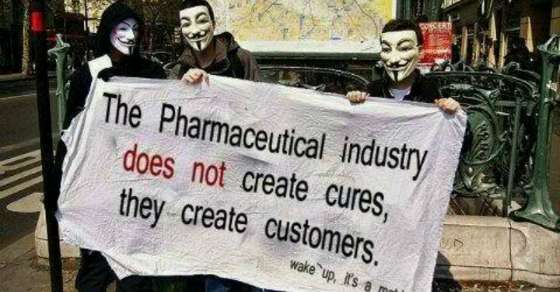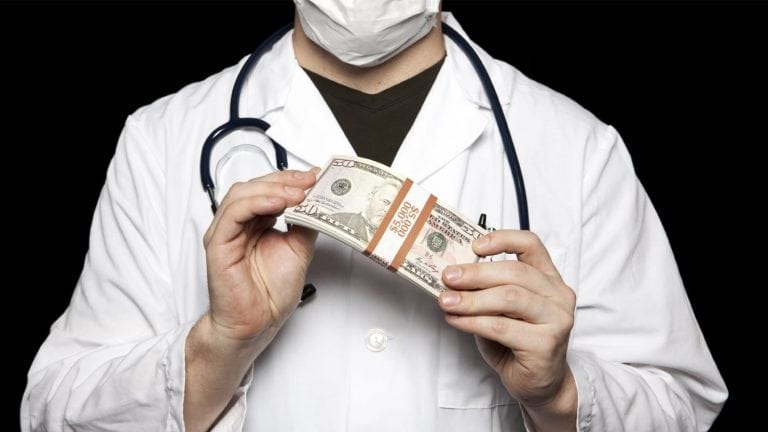 How high are Pharma’s prices? Novartis wants $475,000 a patient for its new cancer therapy. Hep C drugs cost $95,000 for a course of treatment. The immune drug, Actimmune, costs $52,321.80 a month. The parasite drug Daraprim costs $45,000 a month. And the gallstone drug Chenodal costs $42,570 a month.
How high are Pharma’s prices? Novartis wants $475,000 a patient for its new cancer therapy. Hep C drugs cost $95,000 for a course of treatment. The immune drug, Actimmune, costs $52,321.80 a month. The parasite drug Daraprim costs $45,000 a month. And the gallstone drug Chenodal costs $42,570 a month.
But this week in his long-awaited speech, Trump blamed foreign countries for high drug prices in the US and reversed his campaign pledge to use Medicare’s buying power to negotiate lower drug prices. Pharma stock prices rose; the shilling paid off.
Pharma has two lobbyists for every member of Congress. It spends more on lobbying than tobacco, oil and defense contractors combined. It parades patients before public and consumer panels to “provide media outlets a human face to attach to a cause when insurers balk at reimbursing patients for new prescription medications,” writes Melissa Healy of the Los Angeles Times.

The passivity and often complicity of US doctors has allowed this corrupt system to proliferate unchecked for decades, threatening and ruining the health of tens of millions. Only in America, land of sacred capitalism and me first.
And that is not enough for Pharma. Companies also try to incorporate in the UK, Ireland and other overseas locations to dodge the US taxes that fund them such as Medicare. They already manufacture and test drugs overseas because the labor is cheap.
The US government is captured. Pharma operatives head both Health and Human Services and the FDA. The CDC Foundation which receives millions from corporations (not that it affects policies or anything) lists as donors Abbott, AbbVie, Bayer, AstraZeneca, Merck, Pfizer, GlaxoSmithKline Biologicals, Eli Lilly, Amgen, Genentech, Gilead and many more. (Is that why the CDC allows its name to be used in Gilead ads for its Hep C drug?)
Until 2010, PhRMA, Pharma’s top lobbying group, was headed by former Louisiana Rep. Billy Tauzin who resigned from Congress where he chaired the committee which oversees the drug industryonly to immediately reappear as the leader of PhRMA where he drew a $2 million salary. No conflict of interest there.
Tauzin had played a key role in shepherding the Medicare Prescription Drug Bill through Congress which prohibited government negotiation of lower drug prices and Canadian imports. “It’s a sad commentary on politics in Washington that a member of Congress who pushed through a major piece of legislation benefiting the drug industry, gets the job leading that industry,” Public Citizen’s President Joan Claybrook said.
Two-thirds of Pharma lobbyists previously worked for Congress or federal agencies reports the New York Times. An aide to former Michigan Rep. John D. Dingell now works for PhRMA, and an aide to former Iowa Sen. Tom Harkin, who was the chairman of the Senate health committee “is now a top lobbyist for Merck.” Gary Andres, former staff director of the House Energy and Commerce Committee now lobbies for biotech companies. And the list goes on.
 Having captured Congress, you wouldn’t think Pharma would need a charm offensive. Yet it spends millions trying to convince the public it has our interests at heart as it raises our taxes and health care costs. Currently, “America’s Biopharmaceutical companies” are running their “Go Boldly” campaign, ennobling their work with the pay-off line “here’s to permission to fail.”
Having captured Congress, you wouldn’t think Pharma would need a charm offensive. Yet it spends millions trying to convince the public it has our interests at heart as it raises our taxes and health care costs. Currently, “America’s Biopharmaceutical companies” are running their “Go Boldly” campaign, ennobling their work with the pay-off line “here’s to permission to fail.”
Yes, Pharma knows a lot about “permission to fail.” Over 20 of its drugs have been withdrawn from the market in recent years because they were so dangerous—-after maximum money was made of course. They include Vioxx, Bextra, Baycol, Trovan, Meridia, Seldane, Hismanal, Darvon, Raxar, Redux Mylotarg, Lotronex, Propulsid, phenylpropanolamine (PPA), Prexige, phenacetin, Oraflex, Omniflox, Posicor, Serzone and Duract.
Pharma also runs a sappy “Hope to Cures: The Value of Biopharmaceutical Innovation and New Drug Discovery” campaign that showcases patients whose lives were saved by expensive drugs. “If you object to our six-digit drug prices you are signing the death warrant for these patients,” the sleazy campaign seeks to convey.
Two lies lurk under the PR stunt. First, most of Pharma’s profits come from non life-saving drugs that treat acid reflux, ADHD, poor eating habits and a host of trumped up psychiatric illnesses. Secondly, research accounts for only one-fifth of Pharma’s drug costs. Most drug costs Pharma seeks to recoup are for marketing––the ask-your-doctor ads you see on TV––and, of course, lobbying.
 In his zeal to prove to his antagonists in the War Party that he is as bloodthirsty as their champion, Hillary Clinton, and more manly than Barack Obama, Trump seems to have gone “play-crazy” — acting like an unpredictable maniac in order to terrorize the Russians into forcing some kind of dramatic concessions from their Syrian allies, or risk Armageddon.However, the “play-crazy” gambit can only work when the leader is, in real life, a disciplined and intelligent actor, who knows precisely what actual boundaries must not be crossed. That ain’t Donald Trump — a pitifully shallow and ill-disciplined man, emotionally handicapped by obscene privilege and cognitively crippled by white American chauvinism. By pushing Trump into a corner and demanding that he display his most bellicose self, or be ceaselessly mocked as a “puppet” and minion of Russia, a lesser power, the War Party and its media and clandestine services have created a perfect storm of mayhem that may consume us all.— Glen Ford, Editor in Chief, Black Agenda Report
In his zeal to prove to his antagonists in the War Party that he is as bloodthirsty as their champion, Hillary Clinton, and more manly than Barack Obama, Trump seems to have gone “play-crazy” — acting like an unpredictable maniac in order to terrorize the Russians into forcing some kind of dramatic concessions from their Syrian allies, or risk Armageddon.However, the “play-crazy” gambit can only work when the leader is, in real life, a disciplined and intelligent actor, who knows precisely what actual boundaries must not be crossed. That ain’t Donald Trump — a pitifully shallow and ill-disciplined man, emotionally handicapped by obscene privilege and cognitively crippled by white American chauvinism. By pushing Trump into a corner and demanding that he display his most bellicose self, or be ceaselessly mocked as a “puppet” and minion of Russia, a lesser power, the War Party and its media and clandestine services have created a perfect storm of mayhem that may consume us all.— Glen Ford, Editor in Chief, Black Agenda Report 




